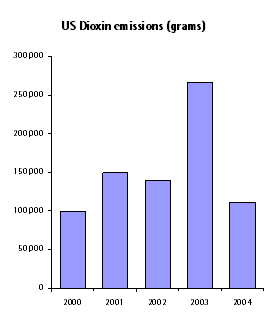Good news about pollution? The U.S. EPA says so. This Washington Post story makes it seem like the U.S. made great strides in reducing toxic emissions in 2004.
The Environmental Protection Agency said Wednesday that chemical pollution released into the environment fell more than 4 percent from 2003 to 2004…The agency said releases of dioxin and dioxin compounds fell 58 percent; mercury and mercury compounds were cut 16 percent; and PCBs went down 92 percent. [Emphasis added.]
Now, the fall in dioxins in particular seemed like pretty big news. But it also struck me as a bit suspicious. So I looked into the numbers a bit.
 The EPA’s Toxics Release Inventory Explorer is pretty simple to use, so it didn’t take long to zero in on why exactly dioxin emissions fell so much. The basic scoop: It’s not so much that dioxin emissions fell in 2004 as they spiked in 2003. The nation’s dioxin emissions (at least, those captured by the TRI) in 2004 were comparable to levels from 2000 through 2002. The 58 percent "decline" was just relative to 2003, which was abnormally high.
The EPA’s Toxics Release Inventory Explorer is pretty simple to use, so it didn’t take long to zero in on why exactly dioxin emissions fell so much. The basic scoop: It’s not so much that dioxin emissions fell in 2004 as they spiked in 2003. The nation’s dioxin emissions (at least, those captured by the TRI) in 2004 were comparable to levels from 2000 through 2002. The 58 percent "decline" was just relative to 2003, which was abnormally high.
Then the question becomes, what happened in 2003? Apparently, there was a single wood-preserving facility in Lousiana responsible for the 2003 spike. (I don’t know for sure, but I’d guess they landfilled a bunch of contaminated waste.)
So the national "good news" story about dioxins in 2004 — a 58 percent decline in releases — turns out to be, if anything, a bad news story about 2003. Or more properly, it’s an artifact of the way the data are reported: the dioxin "released" in 2003 was likely just transferred from one place to another, in a way that triggered EPA’s reporting requirements.
The thing is, it took just a few of minutes to figure out that the EPA’s press release was, at least in part, hot air. Obviously, reporters are under tremendous pressure to churn out stories. But I do wish that basic fact-checking was a higher priority for them. Bum facts passed off as "good news" should be recognized for what they are: a form of toxic information pollution.
